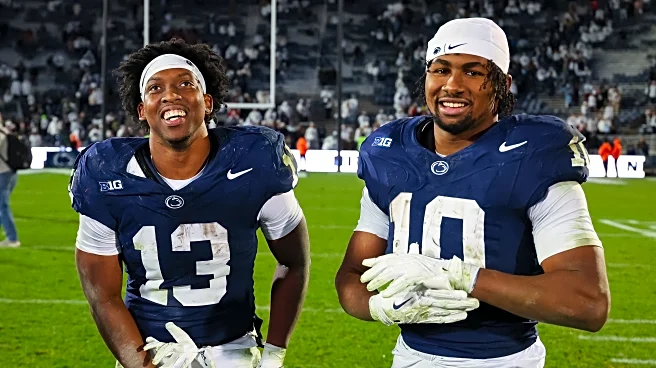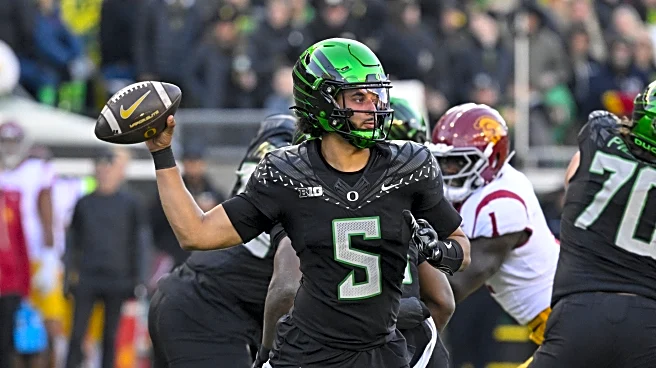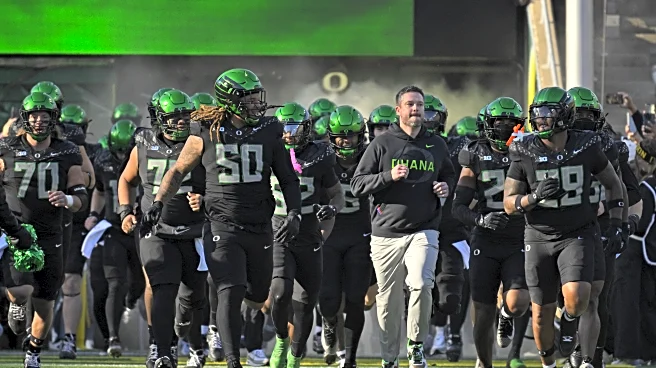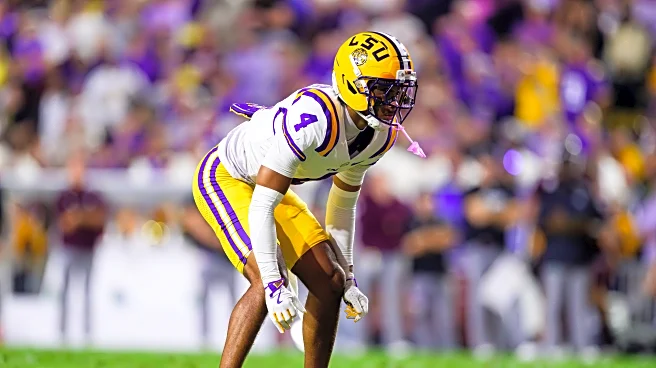Once Oregon scored to go up 42-27 with only 5:22 left the rest of the game was excluded as garbage time. At that point USC was in desperation mode to not only score but do so quickly, while Oregon was primarily
concerned with running clock. Because the punt return touchdown took the place off an offensive possession, Oregon had 9 non-garbage time drives, while the Trojans had 10.
Six of Oregon’s nine meaningful possessions were full-field drives (40+ yards) that resulted in a touchdown. While the raw stats only list one turnover for Oregon (a 3rd quarter interception), their two other empty drives ended on plays that could be seen as having a similar effect: the Ducks’ first possession of the third quarter ended when a sneak failed to gain a full yard and gave the ball back to USC in Oregon’s half of the field, and a fumble in the backfield when the QB and RB collided ended the the Duck’s first drive of the 4th quarter, though they at least got to punt the ball away.
USC had five-full field drives outside of garbage time, four of which ended in touchdowns while the fifth got into field goal range but bounced off the uprights at the end of the first half. None of their remaining five possessions lasted more than six plays.
While it is outside of what I study in these film reviews, it is worth noting that there was a great deal of sloppiness by both teams in terms of discipline and special teams play. The many deadball fouls came close to completely canceling each other out, and were less prevalent in the second half after what I am sure were some choice words from each coaching staff in the locker room.
The Trojans were badly hurt by special teams gaffes. The punt return was no worse than surrendering a standard touchdown drive, and could even have ended up being slightly better that had USC scored on their last possession of the 2nd quarter. Fortunately for Oregon the Trojans missed their field goal attempt at the end of that drive. While USC had a kickoff go out of bounds, the Ducks were very lucky that when #36 K Atticus Sappington slipped while kicking off in the second half the result was the equivalent of a well executed squib kick. The biggest disaster was a leaping penalty on a missed field goal attempt by the Ducks in the 2nd quarter that extended what turned out to be a touchdown drive, essentially a turnover on special teams.
Offense
Oregon’s offense was once again forced to adjust due a large number of injured starters. Neither #2 WR Gary Bryant Jr. nor #1 WR Dakorien Moore were available. On the first offensive posession of the game #11 WR Jeremiah McClellan was hurt, but he played through the pain for the rest of the day.
The unavailability of two of top receivers was predictable, but #76 LT Isaiah World was listed as questionable on game day and did not start. Though World did rotate in for two drives in the first half and one in the second, most of the snaps were taken by R-Fr. #59 OT Fox Crader. Starter #72 C Iapani Laloulu left the game injured in the first quarter and never returned, replaced by R-Sr. #70 Charlie Pickard. Given that he has a known athletic ceiling and was coming in cold Pickard did admirably, with only two snapping problems and posting an error rate in blocking just a touch above the starters on my tally sheet. Starting right tackle #71 OT Alex Harkey also had to leave the game just before the start of the 4th quarter, and for a single drive Oregon had to put backup #73 OL Kawika Rogers (who normally plays guard) on the right side. Fortunately Harkey was able to return after a single drive where the offense went three-and-out.
Due to the injury situation, this game is not representative of the evolution of the offensive line’s play as the season has progressed. It is a testament to the blockers’ talent and the depth of the roster that they were still able to move USC’s undersized front-7 around for efficient gains almost at will. The lack of high-level coordination among the blockers meant explosive runs were hard to come by but rushing efficiency was well above championship level. The passing game was also highly efficient, though not quite as much as the rushing game, and hit the championship threshold in explosiveness and adjusted yards per passing attempt.
Even with a hodge-podge offensive line, Oregon was able to run the ball effectively against a woeful USC rush defense. As was noted in hythloday’s preview USC’s front seven simply lacks the size, talent, and experience to withstand a competent rushing attack, and in an extended contest a lack of rotation compounds the Trojans’ problems with fatigue issues. Below is a representative sample of successful rushing plays.
(Reminder – You can use the controls in the bottom right of the embedded player to alter the playback speed and/or enter full screen mode.)
- :00 – Initially the backfield motion looks like a standard inside zone run to the offense’s right. Based on the leverage of the blocks it appears like the design was always for #6 RB Whittington to cut back to the left and follow #9 TE Ja. Johnson. Sure enough the young linebacker over pursues the initial motion. Once the deep safety has to make the tackle the offense is already ahead of the chains.
- :16 – The Ducks are in the red zone and have both tight ends on the field. USC expects a run right up the middle and went to their heavy 5-2-4 package with three defensive tackles. Oregon uses this against them by pulling TE #18 Sadiq across the formation and having QB #5 Dante Moore read the defensive end to the offense’s left. Confused by all the motion, USC #1 DE Crawford gives Moore access to the sideline. Sadiq is supposed to block the corner, but when that defender reacts slowly to the run he redirects to the safety.
- :42 – In previous years an outside zone toss to the boundary had been a staple when OC Will Stein needed to convert a third down on the ground, but I hadn’t seen it this season so far. In this case it was brought out on first down and run to the field. Sadiq pins the defensive end inside while Ja. Johnson and #71 RT Harkey pull around him. The toughest assignment is #11 WR McClellan against USC #18 LB Gentry, who makes a quick diagnosis and out leverages McClellan to the outside. In response Whittington cuts downfield and a quick shove from Ja. Johnson lets him slip through the 6’ 6” defender’s long arms. Notice #75 LG Pregnon racing downfield to move not just one but two of his former teammates.
- 1:15 – It’s the fourth quarter and with an 8-point lead Oregon is looking to get the wooden horse inside the walls with a clock-eating scoring drive. Whittington is lined up tight to formation as a receiver on the offense’s left while #23 RB Hill is behind Moore in the pistol. Whittington motions into the flat and Moore fakes a look to him long enough to freeze the backside pursuit. Backups #59 Crader and #70 Pickard pull around Ja. Johnson who pins the defensive end. If McClellan could seal the linebacker Hill probably scores, but as is he still gets 7 yards.
With so many backups in, the overall error rate on the offensive line wasn’t as good as it has been in past weeks. As Oregon most often had two tight ends on the field the Trojans were usually in a 4-3 look with the long-limbed USC #18 LB Gentry lined up as the SAM toward the passing strength of the formation. USC also often had only a single high safety to add another run defender. Throwing enough bodies at the line of scrimmage will always get some stops. Below are examples of unsuccessful rushing plays.
- :00 – The Ducks are running their counter play to the offense’s right. The playside defensive end gets inside of Ja. Johnson to contact Harkey while Pregnon loses control of his man who then engages #74 RG Iuli. This leaves nobody to disengage from the double team on the playside defensive tackle to move up to the linebacker, who is free to make the play.
- :15 – In the redzone the Ducks are trying to play bully ball by lining up #56 OL Trent Ferguson as a TE to the offense’s right. USC has countered with three defensive tackles. The blocking is another version of counter with Pregnon and Crader pulling to the right as Whittington starts left then bends his path to follow them. Ferguson gets too high coming out of his stance and is shoved into Crader, which allows the linebacker to scrape over and get to Whittington in the hole.
- :29 – In third and short USC is risking one high safety and cramming eight players in the box. Most of the defenders are on the offense’s right facing the two tight ends so there is a chance for the guard and tackle to pull to the left and gain a numbers advantage. Pickard isn’t quick enough to snap the ball and get over the 3-tech who proceeds to slow down #0 RB Davison. The running back then trips over Iuli’s foot when he gets stoned by the defensive end and Harkey whiffs on the linebacker.
- :42 – The wide alignment of the defensive end to the offense’s left causes issues here. Crader initially moves as if to double team the defensive end with Sadiq, keeping his head up to see how the linebacker reacts. With the DE lined up outside of Sadiq though he moves too far and then slips on the turf (something I noticed happening to Oregon players several times). This creates a lane for the linebacker to shoot through and tackle Davison for a loss.
Still short-handed at the wide receiver position, the Ducks frequently threw in 12-personnel to take advantage of their two talented tight ends. Sadiq was frequently split out as an additional receiver and did well there. The most explosive pass catcher was #4 WR Malik Benson who has continued to be able to take the top off of defenses even with the absence of #1 WR Dak. Moore. Oregon didn’t benefit from as many pass interference calls as USC, mostly because their receivers were so open the Trojans defenders didn’t have the opportunity. Below is a sample successful passing plays.
- :00 – This simple slant route to Benson, the inside receiver to the offense’s right, becomes an explosive gain because of high level play from both quarterback and receiver. Moore sees the gap between the linebackers before the snap and looks down the middle of the field to freeze the MIKE and the deep safety. Once he glances in Benson’s direction he sees the linebacker over him (Gentry again) has given up inside leverage and he delivers a pinpoint throw into the window between the two defenders. Benson turns his body to secure the catch but keeps his feet moving to break into the open field.
- :17 – USC is showing a seven-man pressure but the defensive tackles bail into coverage, blitzing five. A communication error in the secondary leaves #14 WR Lowe streaking open for a touchdown, but Moore doesn’t have time to find him since there’s a free rusher to Moore’s right after the play-action fake as Ja. Johnson releases into the pattern. But by the same token the pressure has left the flat undefended so Moore fills the void by dumping off to Ja. Johnson who has plenty of room to run.
- :36 – I had more RPOs on my tally sheet in this game than I had seen in recent weeks. This counts as a screen (one of 6 such playcalls, 5 of which succeeded, much higher than usual) since McClellan is behind the line of scrimmage when he makes the catch. This had the potential to go even further if the linebackers hadn’t been so fast. Even as it is, with the safety bailing deep Sadiq and Ja. Johnson double team the corner to clear the way for a first down gain.
- 1:00 – I’m not sure which of the linebackers was mistaken on this play, but there shouldn’t be two of them on Ja. Johnson as Sadiq streaks past between the safeties widening toward the sidelines. Moore has a secure pocket (despite three backup linemen being in on this play) and delivers an elite throw for his athletic tight end to go up and secure.
I didn’t notice an over-arching theme to failed passing plays while charting this game. There was a mixture of QB errors, some pressure getting through, and two dropped passed. Here are examples of failed passing plays.
- :00 – The MIKE blitzes at the snap which, combined with #76 LT World being unable to anchor forces Moore to step up in the pocket. By then two more starters have lost control of their assigned defenders and the QB has to rush the throw to avoid a sack. Whittington would have room to turn upfield with an accurate pass but this ball is too low for him to secure.
- :19 – The outside defender over the teacup to the offense’s left turns his hips too early and leaves McClellan wide open on an out route. The Autzen turf monster strikes again and the receiver slips as the ball arrives, leading to a drop.
- :35 – This is another RPO, with a route combination designed to work against man coverage. The plan is for Benson to rub the linebacker while the corner is pulled out of position following him, leaving Sadiq free access to the sideline. Moore reads his key correctly since the linebacker doesn’t widen at the snap. But because the defense is in zone the corner doesn’t follow Benson, he just waits to tackle the catch. The result is an incomplete pass as Sadiq never had a chance to turn downfield.
- :57 – The offense is trying to get the defense out of alignment with a TACO formation: Harkey is lined up between Crader and Ja. Johnson to the offense’s left while Sadiq fills in at right tackle. Sadiq needs to chip the DE before he releases downfield, as it is Moore only has time to throw the ball at Whittington’s feet.
Defense
The Trojans were probably unsympathetic about Oregon’s injury situation, as USC lost their own center in the first quarter of this game after having to frequently shuffle their lineup this season. The Trojans’ rushing game never got any traction, netting only one run that hit double digits.
As expected, USC’s talented receivers made explosive plays all night long. None of the Trojans’ scoring drives could be described as methodical – USC either got at least one explosive pass reception or that possession fizzled out. Indeed, aside from a shortened field following a failed 4th down sneak that gave USC the ball near the 50, the Trojans needed two explosive receptions on each of their other three touchdown drives. While the Ducks were underwater in terms of passing efficiency defense, and well below where the defense wants to be in terms of pass explosiveness prevention, USC’s offense overall still wasn’t consistent enough to make up for the complete lack of a complimentary running game.
It should be noted that four defensive pass interference penalties are included in the efficiency and explosive passing numbers, but not the adjusted yards per attempt.
DC Tosh Lupoi chose to only use heavy personnel in specific down and distance situations rather than always putting an extra run defender on the field against two tight ends. Even playing mostly nickel with 2 high safeties, USC struggled to find any push against Oregon’s front. Here is a sample of successful rush defense.
- :00 – USC is anticipating man coverage in the low redzone and tries to take advantage by running against a five-man box. Lined up at 3-tech to the offense’s left #1 DT Alexander throws the guard to the ground and trips up the back.
- :13 – The Trojans try to gain a numbers advantage with a sweep to their strongside with USC #6 WR Lemon using the RB as an additional blocker. The sideline defender, #22 DB Canady, steps around the lead block forcing Lemon to try to hurdle #31 S Thieneman. The two combine on the tackle for less than a yard gained.
- 41 – By alignment, the defense isn’t respecting the run with two high safeties and Thieneman as the only middle field defender 10 yards deep . From the offense’s right #28 LB Boettcher comes on a blitz but stays under control. When he sees the play is a run he redirects for a TFL as Alexander breaks through the line.
- :50 – The Trojans have two tight ends to the offense’s right, but Oregon is sticking with a 2-deep nickel configuration on first down. There is plenty of eye candy in the backfield as the H-back pulls around for a split flow run while the receiver comes the other way on a fake end around motion. None of that matters because immediate penetration by #10 DE Uiagalelei forces the runner to bounce outside where Thieneman can step around the guard’s block and stop his progress before #44 OLB Tuioti arrives to clean up.
What little success the Trojans found on the ground typically came from getting USC #14 QB Maiava involved in the ground game. The longest run from any player besides the quarterback outside of garbage time was 6 yards. Occasionally USC could lean forward to stay ahead of the chains in short-yardage situations but that was about it. Below are examples of unsuccessfully defended rush plays.
- :00 – The proper defense of this counter play to the offense’s left begins well when Uiagalelei wrong-arms the pulling guard. With the TE headed outside LB #26 Jackson (healthy enough to see the field again) has to follow him outside instead of getting stuck inside and allowing the pulling blocker to get to #4 CB Finney.
- :08 – Uiagalelei is lined up on the offense’s left and comes out of his two-point stance waving his arm around with his weight unevenly distributed. This lets the pulling guard seal him inside and open the edge. Jackson is slow to react to the snap but shows off his elite lateral speed to chase the back down from behind as Thieneman runs the alley.
- :21 – Maiava has been used as a runner earlier in the season, but hadn’t had a carry until this play late in the 1st half on Saturday. As such, Tuioti isn’t thinking about a possible QB keep and undercuts the TE pulling across the formation. He needs to attack the blocker’s inside shoulder to slow his progress and be in position in case of a give to the RB. Canady plays the give too aggressively, moving inside where the tight end can now seal the edge for the quarterback. This was USC’s longest run of the day and their only explosive rush.
- :38 – It’s fourth and short in the red zone and the defense is selling out against a short pass or QB run with no safety over the top. This gives them the numbers to stop the QB keep, but Tuioti peeks inside when he should be sealing the edge and letting #21 S Flowers fill the B-gap on the offense’s left. This let’s Maiava get to the sideline for 7 yards, USC’s second longest run of the day.
Oregon’s plan to contain the Trojans’ explosive passing game was to keep as many defenders as possible in coverage, blitzing rarely and keeping two safeties deep with few exceptions. With their run game stymied USC also called six screen passes prior to garbage time and the Ducks held serve successfully defending 3 of them. Here is a sample of successfully defended pass plays.
- :00 – With elite receivers but a struggling offensive line, the best way to defend USC’s passing attack has been quick pressure with 4 rushers to get a sack or force a bad throw when Maiava cannot move past his first read. Boettcher shows pressure but then bails into coverage, leaving Alexander 1-1 with the guard who is quickly pushed back. The QB forces a throw into double coverage with pressure coming and Canady nearly gets an interception.
- :20 – On the podcast with hythloday Alicia de Artola Castillo was Cassandra on the walls of Troy, as she prophesied that Maiava would panic and throw an interception early in the 3rd quarter because he was pressing if the game was close or USC was trailing. Sure enough, on 4th and long in plus territory with Uiagalelei closing in the QB locks on to his first read even though Canady is in position to undercut the throw. He should knock this to the ground on 4th down, but his instincts take over and it’s a pick.
- :45 – With #54 Mixon lined up inside of USC #6 WR Lemon the quarterback pulls the ball and throws a quick bubble screen on this RPO. Mixon reacts quickly and shows impressive speed to track down the star wide out for only a 1 yard gain.
- :57 – Maiava needs room to step up in the pocket with perimeter pressure closing in on his left from #9 OLB Purchase and his right from Uiagalelei. Alexander has pushed the guard back into his lap and there is nowhere to escape and in the chaos the ball is fumbled. The Trojans are fortunate to get a chance to punt.
When he had time to read to the field Maiava could find his receivers open for explosive plays. Even when operating from a two-high shell, specific route combinations left Oregon’s defenders one-on-one with USC’s elite receivers and the Trojans generally got the best of these match ups. Below is a sample of failed pass defense.
- :00 – Oregon’s defense had their best coverage defender, #4 CB Finney, shadowing the Trojans’ most physical wideout USC #8 Lane. Both corners are in press coverage to try and prevent receivers breaking open before the pass rush has a chance to affect the play. This leaves Finney in a tough position guarding a deep route to the outside in press man coverage. He’s in decent despite position despite missing his jam off the line. This is simply an accurate throw to an elite wide receiver who will make this play nine times out of ten.
- :21 – Later in the same drive the Ducks are running Cover-3 zone. With the safeties bailing deep at the snap Maiava knows Lane’s route will find a hole in the zone, so he is able to throw the ball before the pressure closes in.
- :41 – The Ducks are in man coverage now, with two safeties over the top. To the field #0 DB Austin slowly back pedals keeping his eyes in the backfield. With #5 Th. Johnson in press coverage over USC #16 WR Hines lined up outside the hash marks Austin needs to check if that receiver is breaking to the inside as the corner has to keep outside leverage. Because Austin never takes his focus off of what is directly in front of him, once the pass is thrown the receiver is already running by him.
- 1:04 – This tunnel screen is quite similar to a play we saw from Oregon’s offense earlier in the season. Uiagelelei is a beat late to react, but Thieneman is quick enough to dodge the block of the guard. Unfortunately he doesn’t sink low enough in his hips as he breaks down for the tackle so the receiver knocks him backwards to set up third and short.












